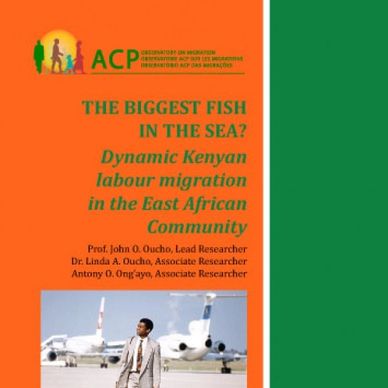Project Reports
Labour Mobility in the East and Horn of Africa (2023)
Youth, Employment and Migration in Eastern and Southern Africa, YEMESA (2017 - 2019)
Youth, Employment and Migration in Eastern and Southern Africa, YEMESA (2017 - 2019)

This report analyses the role of the East African Community (EAC) Protocol on the Establishment of the East African Community Common Market (CMP) and the Intergovernmental Authority on Development (IGAD) Protocol on Free Movement of Persons in the IGAD Region (FMP) in facilitating labour mobility in the East and Horn of Africa (EHoA) region. The report provides an in-depth analysis of the legal and policy context of protecting the rights of migrant workers in the EHoA region, focusing on the EAC CMP and IGAD FMP and national labour provisions of the case study countries, namely Kenya, Rwanda and Uganda. It also discusses the opportunities and challenges of overlapping memberships for the implementation of the IGAD FMP and acceleration of the EAC CMP in relation to labour mobility and migrant workers’ rights based on the experiences of Kenya and Uganda. It also explores the impact of overlapping memberships and COVID-19 on labour mobility while taking into account gender considerations.
Youth, Employment and Migration in Eastern and Southern Africa, YEMESA (2017 - 2019)
Youth, Employment and Migration in Eastern and Southern Africa, YEMESA (2017 - 2019)
Youth, Employment and Migration in Eastern and Southern Africa, YEMESA (2017 - 2019)

The AMADPOC led a two-year project implemented in Kenya, Malawi, Uganda, and Zambia that focused on Youth Employment and Migration in Eastern and Southern Africa (YEMESA). It adopted evidence-based strategies for creating decent employment opportunities and supporting entrepreneurship in the face of the youth population boom Africa is experiencing. It focused on the way migration impacts youth employment, self-employment, and entrepreneurship in eastern and southern Africa. It examined gender differences in migration trends and the causes of youth migration pressures. Furthermore, it provide a profile young African migrant workers, their working conditions, and their opportunities for entrepreneurship.
The research presented in this publication was carried out with the financial assistance of Canada's International Development Research Centre (IDRC). The views expressed herein do not necessarily represent those of IDRC or its Board of Governors.
Evaluation of the African Union Migration Policy framework for Africa (2016)
Youth, Employment and Migration in Eastern and Southern Africa, YEMESA (2017 - 2019)
Evaluation of the African Union Migration Policy framework for Africa (2016)
.png/:/cr=t:2.48%25,l:0%25,w:100%25,h:57.68%25/rs=w:388,h:291.72932330827064,cg:true)
The African Union (AU) adopted the Migration Policy Framework for Africa (MPFA) in 2006 as a non- binding framework and guideline to assist Member States and Regional Economic Communities (RECs) in the formulation of their own national and regional migration policies in accordance with their own priorities and resources.The MPFA was a result of discussions between AU Member States at national and regional level with a view to exploring innovative ways of effectively addressing migration related issues, and also harnessing the benefits of migration for development. This evaluation was commissioned by the African Union in order to assess the extent to which the framework has provided guidance to Member States and RECs in managing migration, and also to provide the basis upon which a continental plan of action on migration can be formulated. To this end, the scope of the evaluation included presenting a situational analysis of migration on the continent, establishing the extent to which Member States and RECs have integrated migration and development into their national and regional development plans and determining the extent to which the MPFA has provided guidance for the management of migration to Member States and the RECs over the past 10 years, highlighting the challenges faced and the opportunities that could be seized moving forward.
MIGRATION and Human Security in the east and Southern Africa Region (2013)
Evaluation of the African Union Migration Policy framework for Africa (2016)
The baseline study benchmarks the migration state of play in the Eastern and Southern African (ESA) region. Using a multidisciplinary approach, the study analysed the relationship between migration and human security and identified causes of migration situating them within the security dynamics of the region. Five (5) Mechanisms were identified along with key actors and institutions working with regulatory frameworks. The study aimed to guide IGAD programme interventions within the region. The study was undertaken in seven countries: Uganda, South Sudan, Djibouti, Tanzania, Zambia, Ethiopia and Kenya.
The biggest fish in the sea? Dynamic Kenyan labour migration in the East African community (2013)
The biggest fish in the sea? Dynamic Kenyan labour migration in the East African community (2013)

This study assesses the Kenyan policy and institutional framework concerning South–South labour migration with particular focus on the East African Community (EAC) countries. It focuses mainly on one particular policy instrument, the East African Community Common Market framework. The research further looks at country-specific policies in relation to the common market framework. The study relied on desk research into the existing literature and public records; key informant interviews (KIIs) of policymakers in respective EAC Partner States’ governments with the exception of Burundi; as well as with private labour recruitment agencies in each country. The study has found that the EAC framework is not sufficiently implemented at the national level and only inconsistently incorporates other country-specific policies dealing with labour migration in the region. The study underlines Kenya’s dominance in the EAC, especially in terms of its best trained and skilled human resources working in all EAC Partner States. The main recommendation centres on the need for harmonizing national labour policy frameworks and legislation as well as the free movement of labour as enshrined in the Protocol on the East African Community Common Market (PEACCM).
